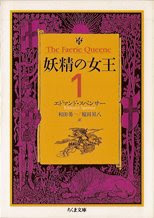The translator was clearly trying to be poetic, using difficult kanji and words that are even archaisms in Japanese, in order to imitate Spenser's medievalizing style.
This is the first stanza of the FQ:
A Gentle Knight was pricking on the plaine,
Y cladd in mightie armes and siluer shielde,
Wherein old dints of deepe wounds did remaine,
The cruell markes of many a bloudy fielde;
Yet armes till that time did he neuer wield:
His angry steede did chide his foming bitt,
As much disdayning to the curbe to yield:
Full iolly knight he seemd, and faire did sitt,
As one for knightly giusts and fierce encounters fitt.
I cut and pasted this from Renascence Editions, which is presumably good enough, though the initial 'A' was cut off (it was probably in a calligraphic image).
Here is the first line in Japanese:
気高い騎士が野に駒を進めていた。
English transliteration:
kedakai kishi ga no ni koma o susumeteita.
Kanji explanation (from memory, not dictionary):
気 -- mind, spirit, intention (looks like 氣 in traditional Japanese and Chinese, 气 in modern Chinese)
高 -- high
い -- this is an adjective that means "noble" or "high-minded" ergo "gentle" (there's even a note showing the English word)
騎 -- horseman
士 -- military professional suffix, so the compound together is "knight"
が -- subject particle
野 -- field
に -- in this case, a sort of locative indicator particle
駒 -- an old fashioned word for horse, which today means "chess piece"
を -- direct object particle
進 -- verb root for "to advance"
め -- 'e' row stem (or base or root I don't f*ing remember the diff) indicating a transitive verb
て -- 'te' form
い -- progressive action modal suffix?
た -- past tense
。-- funny Japanese "maru" period that can also be used for a question mark
My translation:
A noble knight was advancing his steed in a field.
I know. It's very literal. But I used "steed" to re-translate the archaic "koma" for horse ("uma" in modern Japanese) to preserve some poetic effect. Also, Japanese does not have articles, so the difference between "a field" and "the plain" is insubstantial, though I take the English to mean no plain in particular but rather an abstract sort of plain "out there." Japanese does have demonstratives, though, so it is possible to be specific when (and only when) it's necessary. The same goes for personal pronouns. There are ways to indicate possession, but, in this case, we must infer that the horse belongs to the knight (is the use of 駒 with 騎 some kind of kanji wordplay? Koma, Kishi? They do have two parts, including a radical, in common.).
A more literal translation, according to the word order:
A noble knight on a field his steed was advancing.
Sounds like John Milton. Yes, Japanese can be quite Latinate, with its SOV word order. Note that there is no mention of a horse in the English first line. I guess it was difficult to convey the sense of "pricking" given its highly idiosyncratic sense, existing across a broad spectrum of Indo-European (mostly Germanic) languages, but hard to express out of context. "Advancing" is a weak way to suggest the pricks given by a knight to his horse. "Spurring" might have been a better choice, but Japanese has a different kanji for this. How free should I be in my translation of a free translation? To what extent should I even refer to the original?
11.13.2008
Subscribe to:
Post Comments (Atom)





No comments:
Post a Comment